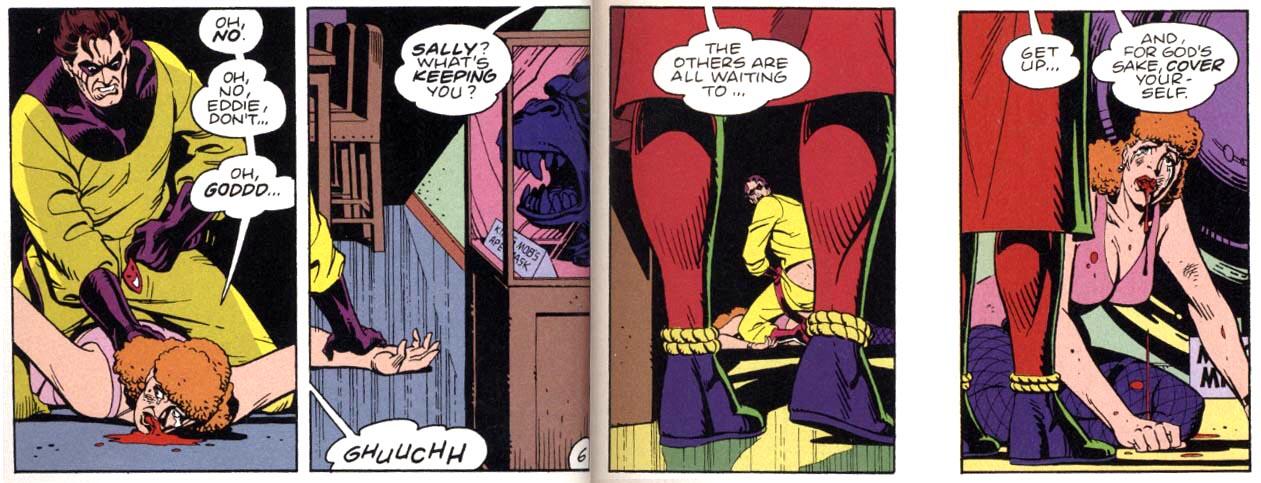Introduction
Watchmen is a series of comic books written by Alan Moore, drawn by Dave Gibbons, and colored by John Higgins. Published by DC Comics between 1986 and 1987, the series is focused on reflecting modern anxieties of society as well as discussing, deconstruct, and satirize the concept of a superhero. Watchmen tells a story of an alternative view in which superheroes came into existence in the 1940s and the 1960s, with their presence dramatically changing the history of the United States.
For instance, with their help, the country won the Vietnam War while the Watergate scandal never came to exist. Ironically, due to the Watchmen representing multiple psychiatric conditions, many readers of the comic series have raised the question of who would watch and care for the superheroes when they are busy protecting the world.
The characters created by Moore are far from being traditional ‘superheroes’ that the public is used to seeing. The Crimebusters group consists of five heroes working undercover: Rorschach, Nite Owl, Silk Spectre, Dr. Manhattan, and Ozymandias. The sixth member of the group is The Comedian, who exhibits a particularly extreme level of violence (see Figure 1). Each of the characters exemplifies severe and diagnosable personality disorders, which adds multiple levels of complexity to the comic book series and the stories in which they get involved regularly.
Exploring Walter Kovacs and Laurie Juspeczyk
Walter Kovacs hides behind the grotesque mask of Rorschach’s. Walter is a man who has traumatizing past full of parental neglect and childhood angst, all of which contributed to his diagnosis of Paranoid Personality Disorder. When he was young, Kovacs was continuously exposed to poverty and crime, which enabled him to eliminate any manifestations of trust toward other people. He is always on the ‘lookout,’ suspicious and assuming the worst to happen. The lack of trust in people, along with the continued suspicion of them, results in the outbursts of violence against criminals despite his maintenance of a boring effect during them.
Laurie Juspeczyk that operates under the guise of the Silk Spectre, also has unresolved childhood trauma as he has to live in the shadow of the heroic success of his mother, Sally Jupiter. The insecurity of never being able to match her mother’s accomplishments paired with the romantic attention from Nite Owl and Dr. Manhattan most likely contributed to her diagnosis of Histrionic Personality Disorder. Juspezyk’s behaviors are volatile, and her emotional state continuously enables to use of various social situations as well as her appearance to attract attention to herself. Due to the lack of belief in their own powers and abilities, Laurie is very self-monitoring and over-emphasizes the role of romantic and intimate relationships in her life.
Her doubts of self-worth are also fueled by the fact that she did not have a father growing up, and discovering that the Comedian raped Sally made her condition even worse. It is worth noting that Laurie’s continuous search for love and affection is not mocked nor undermined in the comic books. Rather, it is illustrated as a lost individual’s desire to reach the desired level of acceptance that she could not reach in her childhood.

Understanding PPD
Paranoid personality disorder (PPD) is a chronic represents a chronic condition classified under Cluster A or eccentric personality disorders. Individuals diagnosed with the condition have the essential characteristic of paranoia, a continuous mistrust and suspicion of other people without having any reasons for having negative thoughts (Klostranec 290). While it is a chronic condition, it is not regularly encountered in clinical settings. According to Vyas and Khan, the prevalence of PPD ranges between 2.1% and 4.41% (10).
It is worth noting that paranoid personality disorder represents a statistically significant disability predictor and is also closely linked to violence and criminal behavior. In addition, as to the pathology of the disorder, “schizotypal, narcissistic, borderline, and avoidant personality disorder traits are commonly comorbid with a paranoid personality disorder, and indeed there is some overlap of diagnostic criteria with those disorders and paranoid personality disorder” (Vyas and Khan ).
In PPD, paranoia does not refer to delusional psychosis exhibited by an individual but rather a “distinctly paranoid cognitive style” (Gabbard 400). Since the nature of the disturbance within PPD is not conducive to identify and perceive one’s own pathological issues, the treatment of individuals with the condition can be complex, especially when subjects experience mistrust of their physicians.
The Influence of Environmental Factors
Researchers are still exploring the possible reasons for PPD development as the distinct reasons for the emergence of the disorder remain unknown. However, the combination of environmental factors may have an influence on the emergence of paranoid disorders in adolescence and adulthood. This is assumed as most personality disorders have developed on the basis of genetic factors, environmental problems such as childhood trauma, verbal abuse of the individual, as well as the impact of his or her peers. These factors suggest that the surroundings of a person are rather contributors than specific causes of personality disorders. The manifestations of personality disorders range from one individual to another and can include but not limited to the following:
- Issues with making and maintaining relationships with other people;
- Difficulty connecting to the emotional issues of other people;
- Inability to manage and control emotions;
- Lacking the competence to cope with life and complicated feelings;
- Difficulty in controlling impulses and behaviors, especially in terms of violence.
Individuals with personality disorders often feel isolated from society and alone, which means that their environments play essential roles in how they feel. If connected with ‘wrong’ people or unable to receive the necessary mental support from peers, individuals can have increased self-harm levels as well as abuse alcohol and illegal substances (Tracy and Wallace 145).
In the case of the Watchmen, the complex psychological profiles of the fictional team’s members-only contribute to the emotional instability of such characters as Walter Kovacs and Laurie Juspeczyk. However, the heroes of the comic book series were intentionally humanized and deconstructed. As mentioned by Ian Thompson in his essay “Deconstructing the Hero,” the characters of the series had to be developed in such a way that would promote the reflection on human disadvantages from multiple angles (2).
The Impact of Childhood
When exploring the characters of Walter Kovacs and Laurie Juspeczyk in regards to their manifestations of PPD, it is notable that their mistrust of the world and the lack of appreciation for other people have contributed to their increased violence. Walter’s character is shown as someone suffering severe paranoia, with the similarities between him and a person with the traits of PPD being evident. Those who develop the condition can experience severe trauma in their childhood, which leads to severe consequences in their behaviors as adults. Both verbal and physical abuse were present in Kovacs’ childhood through his own mother as well as bullies. In Chapter VI of Watchmen, Walter concludes that most of his life consisted of traumatic and painful experiences. Thus, childhood is one of the factors contributing to the development of PPD in adults.
According to the research by Lee, PPD has close connections to childhood trauma and social stress, with at least four cross-sectional studies and one longitudinal research pointing to this fact (153). Childhood emotional neglect, physical abuse, and supervision neglect all predicted increased PPD symptom levels in adolescence and early adulthood. In the cases of both Walter Kovacs and Laurie Juspeczyk, the lack of parents’ attention to their emotional needs in childhood elevated their chances of developing PPD in adulthood.
If to apply the character of Rorschach to exploring PPD as a psychologic condition, it is notable that at first, not much is known about him, pointing to the complicated psychology of the individual. The character considers his identity as a ‘superhero’ to be his real identity, especially when he refers to his mask as his face. The skepticism of the character towards the world and paranoia is reflected in him unmasked carrying the sign stating the “End is Nigh,” which can be seen several times throughout the book.
Therefore, his disguise is not his mask but rather his real face. Although his morality is focused on seeking out and eliminating villains within his storyline, he is convinced that humanity is doomed anyway. In such a contradiction, the paranoid features of his mental disorder are seen, which makes him vulnerable to the external world with the features of PPD furthering as he continues his vigilante work.
The Influence of Biologic Factors
When speaking of the biological factors that contribute to the development of PPD, it is imperative to mention that there is a genetic impact on neurons through neurotransmitters and enzymes that further influence both the function and the structure of the central nervous system (Ma et al. 286). Thus, any abnormalities that lie in the structure and function of the brain have the capacity to influence the development of such structures in the progeny adversely. Thus, personality disorders that originate in early childhood could potentially be the results of gene abnormalities and contributed to the development of conditions alongside environmental factors.
In addition, personality disorders, including PPD, “are also rooted in the interactions between an abnormal temperament (usually considered to be genetically fixed) and an adverse environment (Ma et al. 287). Thus, in Watchmen, the personality disorders attributed to each individual are considered to be a combination of both ‘nature and ‘nurture’ factors rather than being attributed to either one of the characteristics. The characters of Walter and Laurie are complex in their nature as there are both positive and negative emotions that dominate different situations. The combination of biological and environmental components has contributed to the increased aggression associated with PPD.
Attention-Seeking as a Histrionic Personality Disorder Contributor
Attention-Seeking as a contributor to personality disorders rather applies to the character of Laurie rather than Walter. Her behaviors throughout the comic book series can be attributed to histrionic personality disorder. This condition is characterized by the continuous attention-seeking of a subject, his or her emotional overreaction, and seductive behavior (Novais et al. 1). In Laurie’s case, attention-seeking is supported by her lack of confidence in herself as a Silk Spectre of the second generation. Laurie’s mother was also the crime-fighting superhero, and overcoming her fame and success affected the woman on a deeply emotional level.
The romantic relationships that Laurie had with both Dr. Manhattan and Nite Owl are evidence of the woman’s increased desire to be loved, accepted, and seen in a positive light (see Figures 3 and 4). Going back to her childhood, living in the shadow of her mother was not only traumatic but also limiting as she did not receive the necessary level of support that she needed. Similar to PPD, histrionic personality disorder is also a result of childhood events and genetics; however, the distinct causes remain unknown in general psychiatric research.


Concluding Thoughts: Who Watches the Watchmen?
The usual perception of a superhero as a strong-willed and righteous individual is shattered throughout Watchmen. The heroes intended to protect the United States and the world from conflicts and chaos struggle themselves with various psychological issues. Therefore, apart from fulfilling their responsibilities as saviors and heroes, the central characters of Watchmen must save themselves as individuals from dysfunctional paranoia, which is reflected in PPD, avoidance or issues, and antisocial behavior.
Such a state of affairs leaves the heroes of the dystopic society created by Moore extremely vulnerable despite their purpose to protect and isolate people from possible danger. In a world where superheroes require psychiatric help and the elimination of their deepest fears and anxiety, a globally popular question of “who watches the Watchmen?” immediately comes to one’s mind. The human-ness of Watchmen shows that even the strongest and most powerful people have flaws and can struggle with extreme mental problems, which makes the comic books valuable in their exploration of the human psyche.
Works Cited
Gabbard, Glen. Psychodynamic Psychiatry in Clinical Practice. American Psychiatric Publishing, 2014.
Klostranec, Jesse. The Essential Med Notes: Comprehensive Medical Reference and Review for USMLE II & MCCQUE I. T&N, 2012.
Lee, Royce. “Mistrustful and Misunderstood: A Review of Paranoid Personality Disorder.” Current Behavioral Neuroscience Reports, vol. 4, no. 2, 2017, pp. 151-165.
Ma, Guorong, et al. “Genetic and Neuroimaging Features of Personality Disorders: State of the Art.” Neuroscience Bulletin, vol. 32, no. 3, 2016, pp. 286-306.
“Nite Owl and Silk Spectre.” I Pinimg. Web.
“Scan0001.” 4 Bp Blogspot. Web.
Thompson, Ian. “Deconstructing the Hero.” Faculty Georgetown. Web.
Tracy, Kathlene, and Samantha Wallace. “Benefits of Peer Support Groups in the Treatment of Addiction.” Substance Abuse and Rehabilitation, vol. 7, 2016, pp. 143-154.
Vyas, Amy, and Madiha Khan. “Paranoid Personality Disorder.” The American Journal of Psychiatry, vol. 11, no. 1, 2016, pp. 9-11.
“Watchmen-1.” Graphicnovel Umwblogs, 2014. Web.